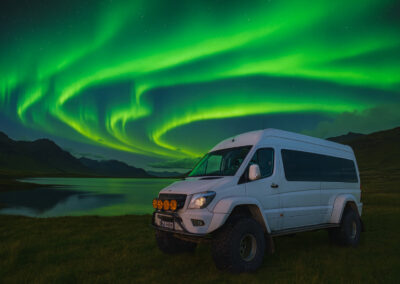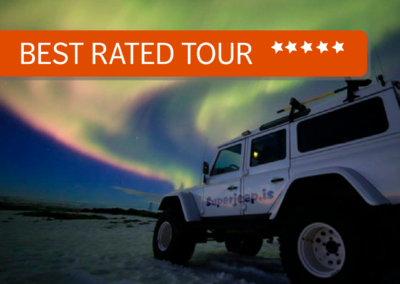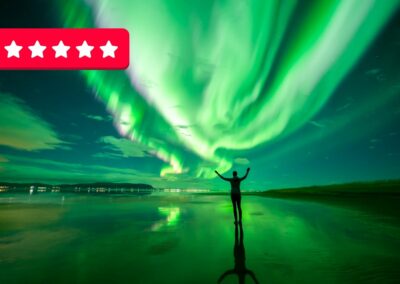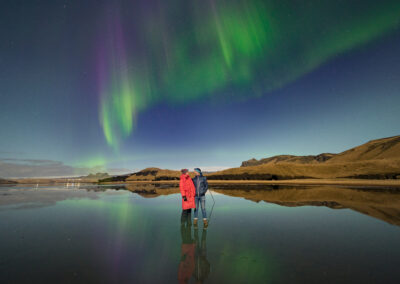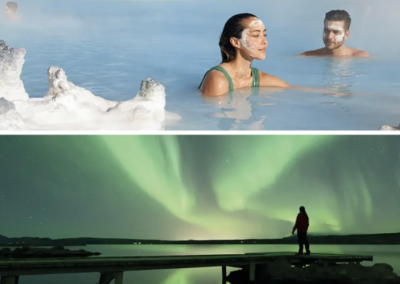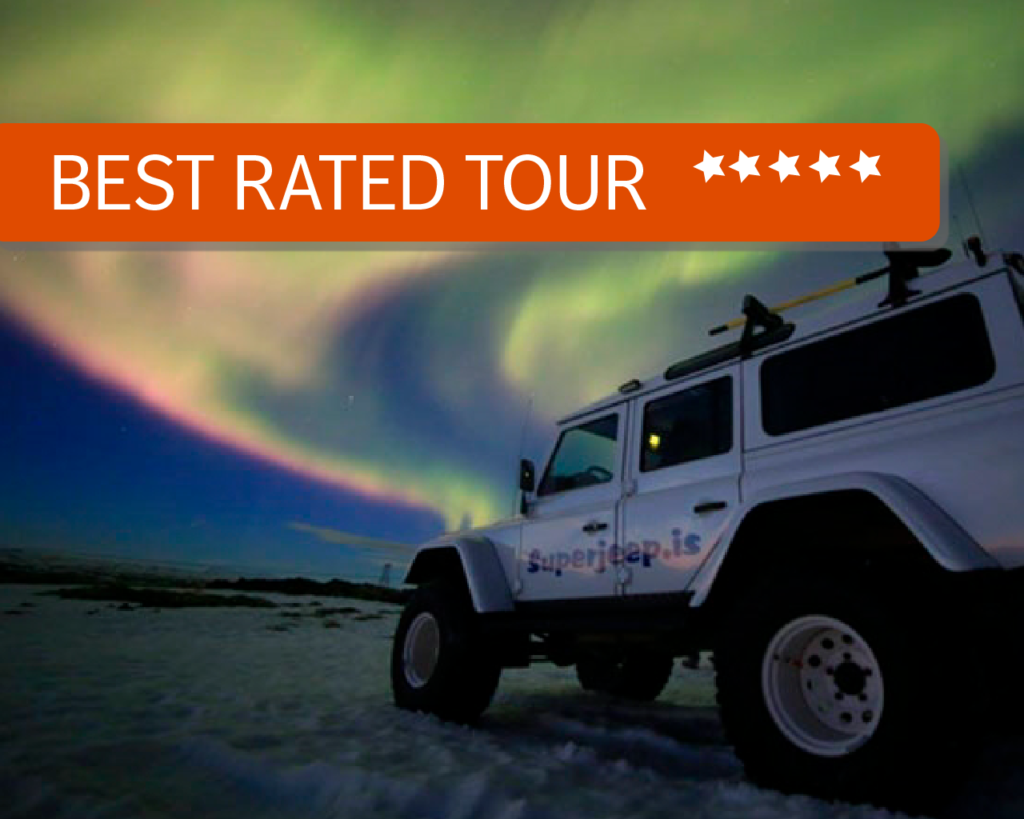THE ULTIMATE GUIDE TO SEEING THE NORTHERN LIGHTS IN ICELAND
Best time
Best places
Best tours
There is perhaps nothing more magical than witnessing the beauty of a Northern Lights display, and it has been a lifelong dream of many. However, those unpredictable, ever dancing lights don’t always show up on cue.
Here is all you need to know to make your aurora dream come true!
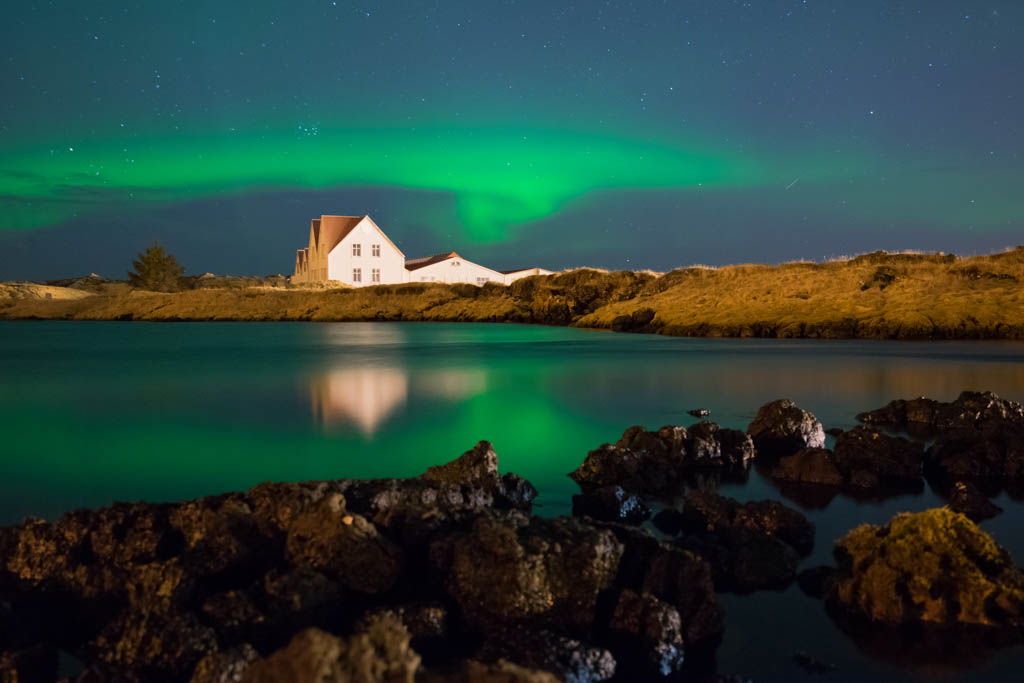
Northern Lights at Straumur, an old farm close to Reykjavík
How to Maximize Your Chances of Seeing the Northern Lights in Iceland
Witnessing the Northern Lights in Iceland is a dream for many, but it requires a combination of knowledge, patience, and a bit of luck. While the Aurora Borealis is a natural wonder, there are key factors that can significantly improve your chances of seeing a stunning display. Here’s what you need to know:
Key Factors for a Successful Northern Lights Hunt
1️⃣ Darkness
2️⃣ Clear Skies
3️⃣ Solar Activity
4️⃣ Minimal Light Pollution
Let’s break down each factor in detail:
🌙 Darkness – The Foundation of Every Aurora Chase
To see the Northern Lights, dark skies are essential. This makes the Aurora hunt a nighttime activity.
In Iceland, the best months to witness the Northern Lights are from late August to mid-April, when the nights are long and the skies are dark enough to spot auroral activity.
While it’s possible to see the lights from Reykjavík on a very active night, your best chance is to head out to more remote areas where artificial light won’t interfere.
☁️ Clear Skies – No Clouds, No Lights
The Northern Lights occur far above Earth’s weather systems, meaning cloud cover can block your view. To maximize your chances, check the Northern Lights forecast, which provides a regularly updated overview of cloud coverage across Iceland.
Icelandic weather is highly unpredictable, and conditions can change within minutes. Because of this, tour operatorsoften wait until the late afternoon to decide whether conditions are good enough to go on a Northern Lights tour.
🔍 If you plan to chase the lights on your own, we recommend checking cloud forecasts just before heading out. Popular sites include vedur.is and belgingur.is, both offering real-time cloud maps.
🌞 Solar Activity – The Power Behind the Aurora
The intensity of the Northern Lights depends on solar activity, which is measured by the KP index. The index ranges from 0 to 9, with higher numbers indicating stronger activity and better chances for a colorful display.
💡 Pro-tip: In Iceland, you don’t need a high KP index to see the lights! Even a KP 2 or KP 3 can result in a beautiful aurora display, especially in areas with dark skies and clear weather.
However, it’s important to remember that the KP index is a forecast, not a guarantee. We’ve seen nights with KP 7 predictions where no lights appeared, and other nights with KP 2 predictions where the sky danced with auroras.
🔗 You can monitor the current KP index here
💡 Light Pollution – Get Away from City Lights
To see the Aurora Borealis at its best, distance yourself from light pollution. The further you are from towns and artificial light sources, the more vibrant the display will be.
Pro-tip: Remember that the Moon also creates light pollution! If you’re hoping to capture the most vivid Aurora photos, plan your trip around a New Moon or a time when moonlight is minimal.
What Colors Can the Northern Lights Display?
The most common auroral color you’ll see is vibrant green, but depending on the elements being ionized in the atmosphere, the colors can vary. The Northern Lights can range from white and pale green to pink, purple, and even shades of red.
- Green: Caused by oxygen at lower altitudes (up to 150 km).
- Red: Caused by oxygen at higher altitudes (above 150 km).
- Pink & Purple: A mix of nitrogen and oxygen reactions.
- White: Often a mix of colors that appear faint to the naked eye but show up more vividly in photos.
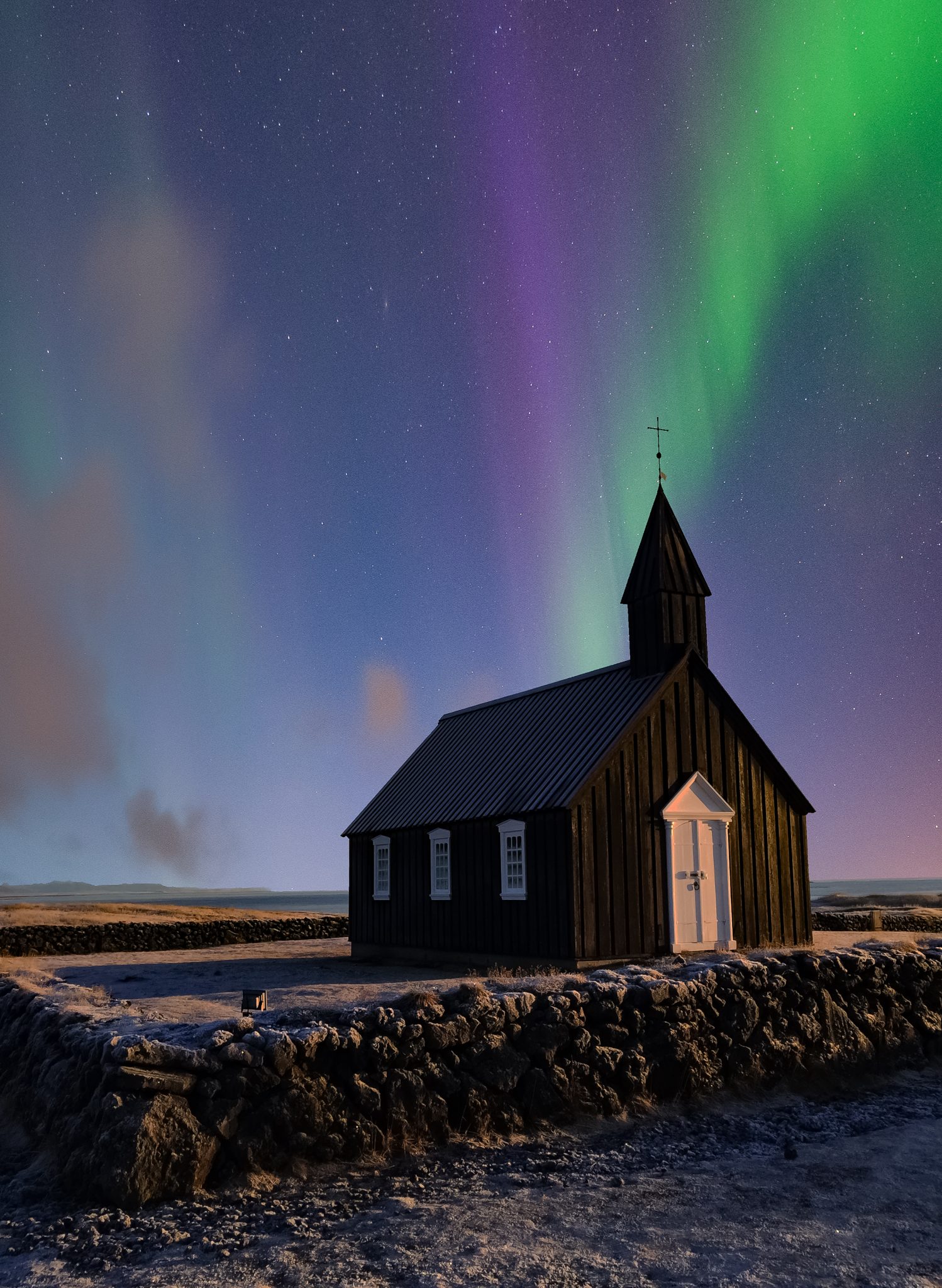
Northern Lights at Búðir
When Is the Best Time to See the Northern Lights in Iceland?
The Aurora season in Iceland runs from late August to mid-April, and any time within this period offers good chances to witness the magic of the Northern Lights. Each month has its own unique charm and advantages, but statistically, the Northern Lights are most active around the equinoxes, in September/October and March/April.
As Northern Light photographers, we personally love September/October – here is why.
How to see the Northern Lights in Iceland
You have several options to see the Northern Lights in Iceland:
- Hunting the lights in Reykjavík,
- Joining a guided tour,
- Renting a car and going on your own hunt,
- Taking a Northern Lights evening cruise.
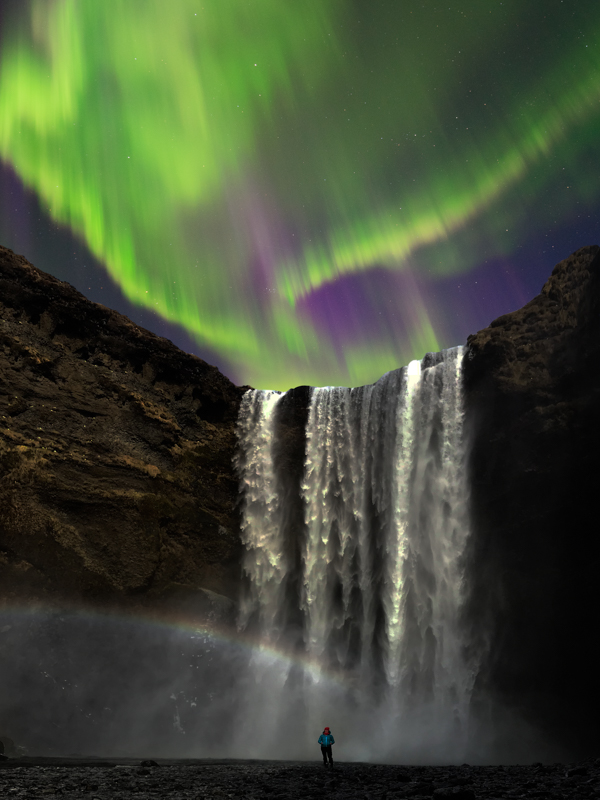
Northern Lights at Skógafoss
Hunting the Northern Lights in Reykjavík: Can You See the Aurora from the City?
One of the most frequently asked questions by hopeful Aurora hunters is:
“Can you see the Northern Lights from Reykjavík?”
The answer is yes – but only if the conditions are favorables.
Northern Lights in the City – What to Expect
While it’s possible to spot the Aurora from within Reykjavík, the experience won’t be as rewarding as when you head out to darker, rural areas. The city’s light pollution from streetlights, buildings, and cars significantly affects your ability to see the Northern Lights clearly.
We often compare it to watching a movie in a cinema with the lights on – you can see what’s on the screen, but it won’t be nearly as vivid or magical. The same goes for the Aurora: dust and artificial light make the lights appear fainter and less colorful to the human eye.
Find here the best spots to see the Northern Lights in Reykjavík.
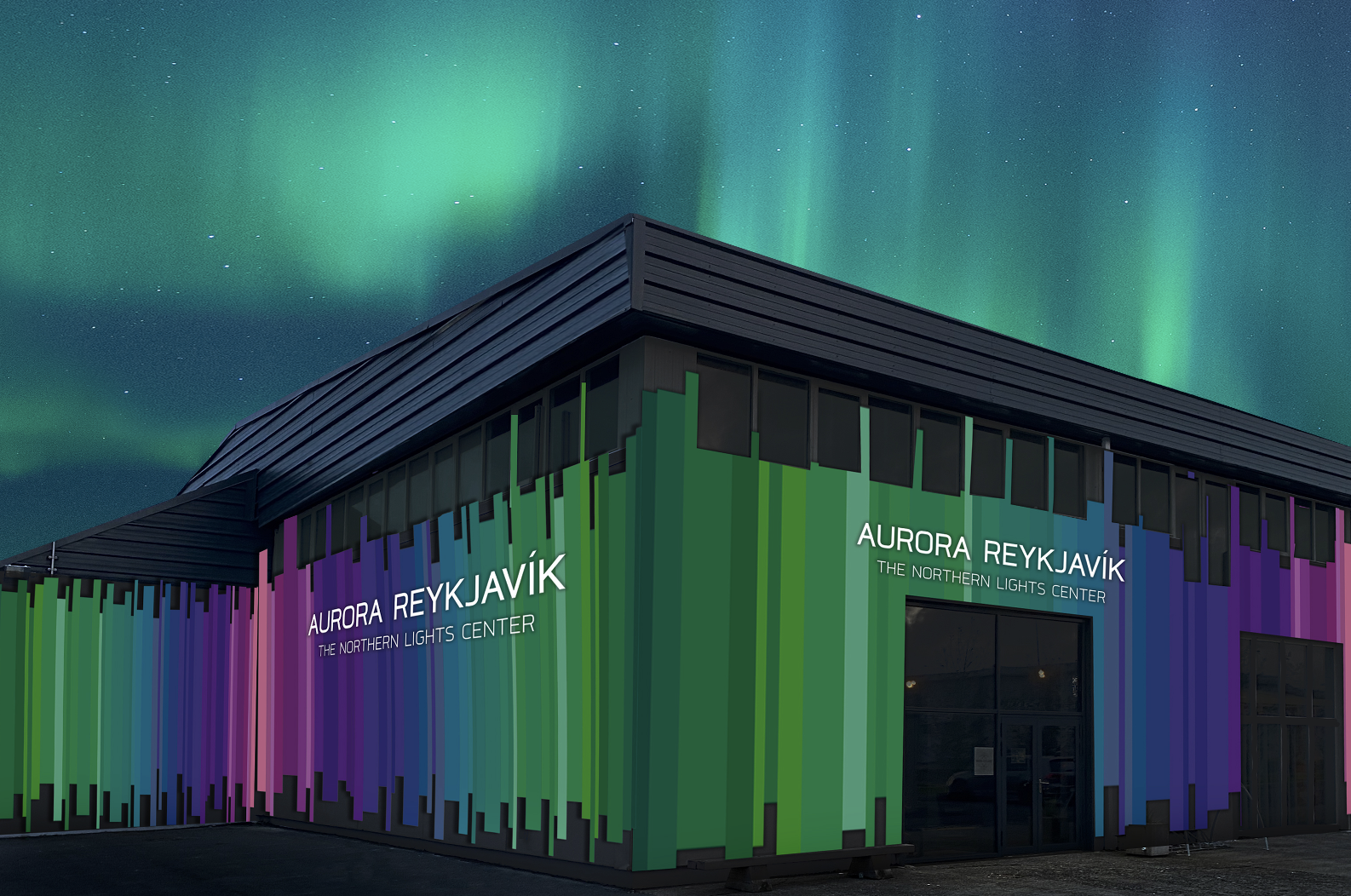
Northern Lights above Aurora Reykjavík
Joining a guided Northern Lights Tour
The most common way to hunt for the Aurora Borealis is to take a guided tour. Several tour operators run excursions regularly from September to April, offering a wide range of different tours for all kind of budgets and personal preferences:
- bus and minibus tours,
- super jeep tours,
- photo tours,
- private tours,
- and a variety of combo-tours that are worth considering.
As unpredictable as the Aurora can be, tour operators try their best to catch the Northern Lights for you and make it a truly unique experience. If your tour gets canceled due to unfavorable weather conditions or no lights are seen, you will get the opportunity to reschedule or retry at no additional charge.
Joining a guided tour is often a fitting choice for a number of reasons:
- You will be under the guidance of an expert who knows where to find the lights and how to photograph them,
- You will be able to easily reach areas where the forecast is the most promising,
- You will be traveling with like-minded people,
- You won’t need to worry about driving in Iceland’s harsh winter conditions.
Those on a budget will appreciate reasonably cheap bus tours, which will take you on a hunt without breaking the bank.
Minibus tours offer a small group experience, and often include valuable extras such as hot drinks on board or photos of you under the Northern Lights taken by your expert guide. These excursions are operated on smaller vehicles than regular bus tours, allowing more flexibility when searching for the right spot to see the Aurora.
If you want to make your Northern Lights hunt a real once-in-a-lifetime experience, we highly recommend choosing a super jeep tour. These excursions surely offer the most personal, immersive experience and the highest chances of witnessing a spectacular display – often off the beaten path.
You can find our favorite tours here.
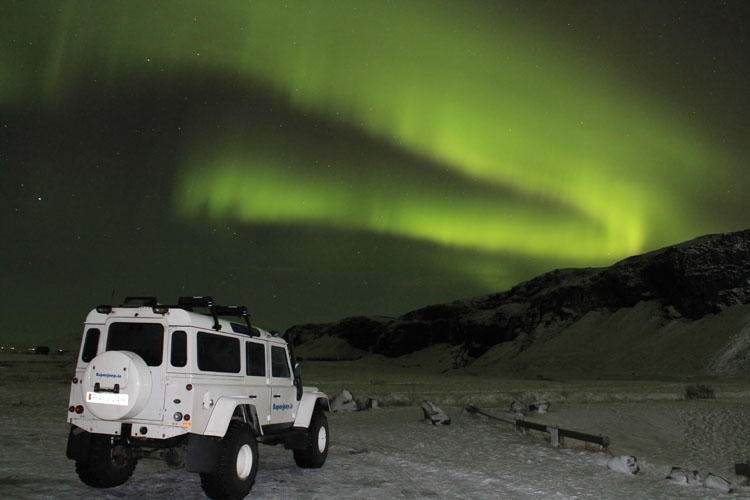
Photo from our popular Northern Lights Superjeep tour
Joining a Northern Lights Evening Cruise
Another way to have an unforgettable Northern Lights experience is to join an Aurora evening cruise. Aurora cruises are designed for comfort, with heated indoor areas featuring a bar and toilet facilities, and warm overalls at disposal for Northern Lights watching on the decks.
Keep in mind that boats do not allow the same degree of mobility as bus or jeep tours can offer, and, due to the movement of the boat, photographing the Northern Lights with long exposure settings may result tricky.
The main strength of a Northern Lights cruise is not so much the ‘hunt’ for the lights itself, as the out-at-sea experience, the enchanting landscapes and stunning views of the Reykjavík or Akureyri skyline under the Aurora.
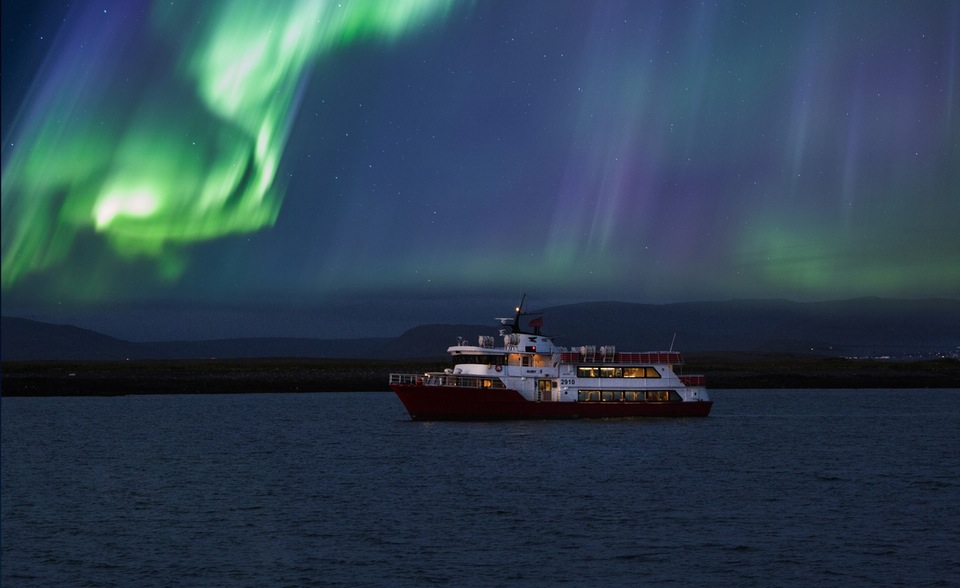
Photo from Reykjavik Northern Lights Cruise
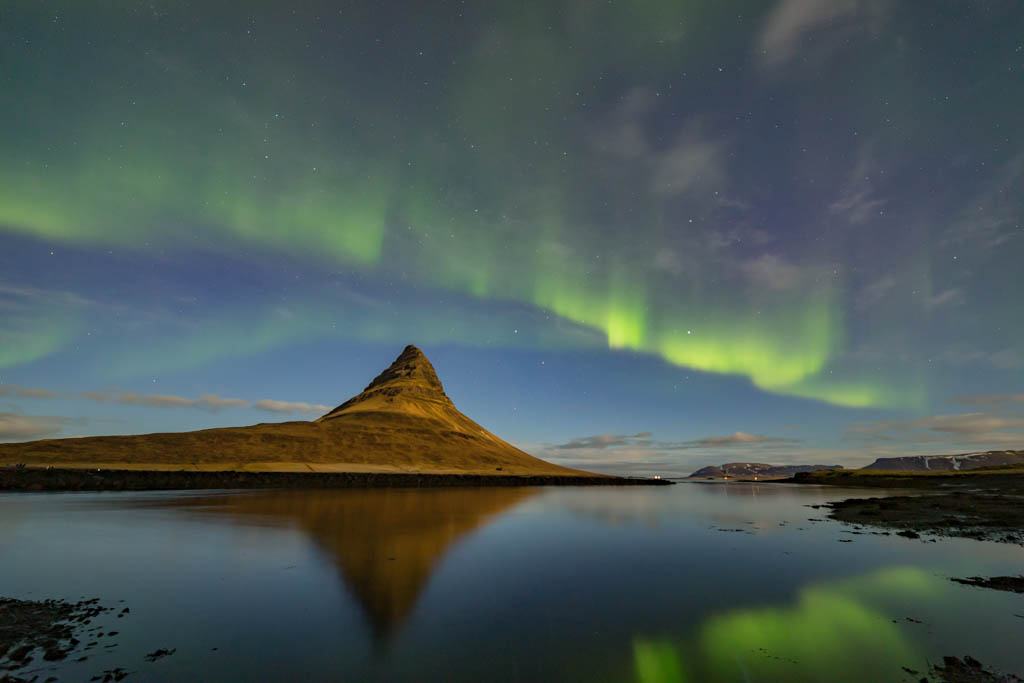
Northern Lights at Kirkjufell
How are my chances to see the lights – and how can I enhance them?
The Sun is constantly emitting plasma, and chances to see the Northern Lights are usually quite good, keeping a few points in mind:
1. Consider a guided tour with an experienced guide
Northern Lights hunting can be tricky, and we highly recommend relying on the knowledge and experience of a local tour guide. People often fail to see the lights for very simple reasons – i.e. being on the wrong side of a mountain range, while the lights are happily dancing hidden behind the peaks.
2. Plan the length of your stay in Iceland wisely
The Northern Lights tend to be very active for 2-3 nights, then quiet for 4-5 nights, in ongoing cycles. The longer your stay the higher your chances.
3. Book your tour for the first night of your stay
In case your tour gets canceled on the first night at your disposal due to unfavorable weather conditions or no lights are seen, you will still have time to reschedule or make use of your free retry. And, even if you are lucky and catch them on your first tour, you might want to try again on your own the following nights!
4. Patience is the key
The Northern Lights tend to occur around magnetic midnight, which converts to 11pm Icelandic time. However, they can occur at any time – darkness required. Dress up properly, grab a thermos of hot chocolate and a blanket, and head out for a long night under the arctic sky!
Best Places to See the Northern Lights in Iceland
Thanks to Iceland’s ideal location under the auroral oval, your chances of seeing the Northern Lights are fairly equal across the country. The key to a successful Aurora hunt is finding clear and dark skies, away from light pollution and cloud cover.
That said, here are some of our favorite spots to chase the Northern Lights:
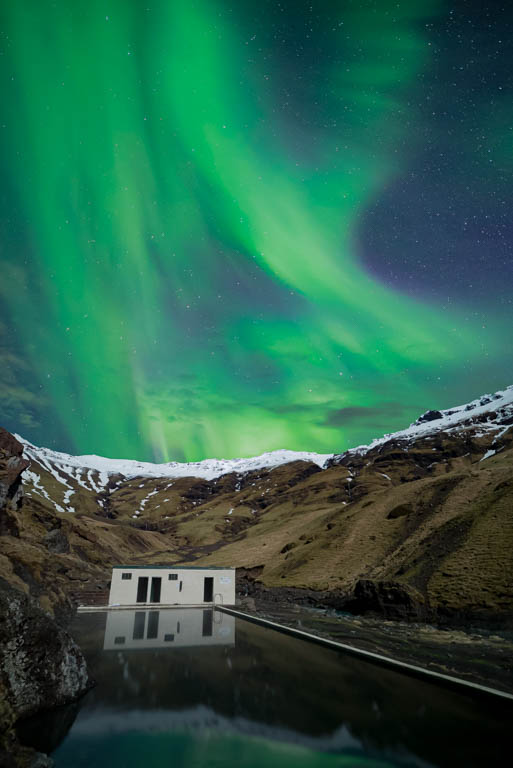
Northern Lights at Seljavallalaug
- Being next to an unfrozen lake, like Þingvellir, gives the opportunity to witness amazing reflections,
- The Blue Lagoon is not only a perfect spot to take a relaxing swim, but also to observe some beautiful auroral displays,
- The countless waterfalls on the south shore of Iceland, like Skógafoss, make a perfect scenic foreground for stunning Northern lights shots.
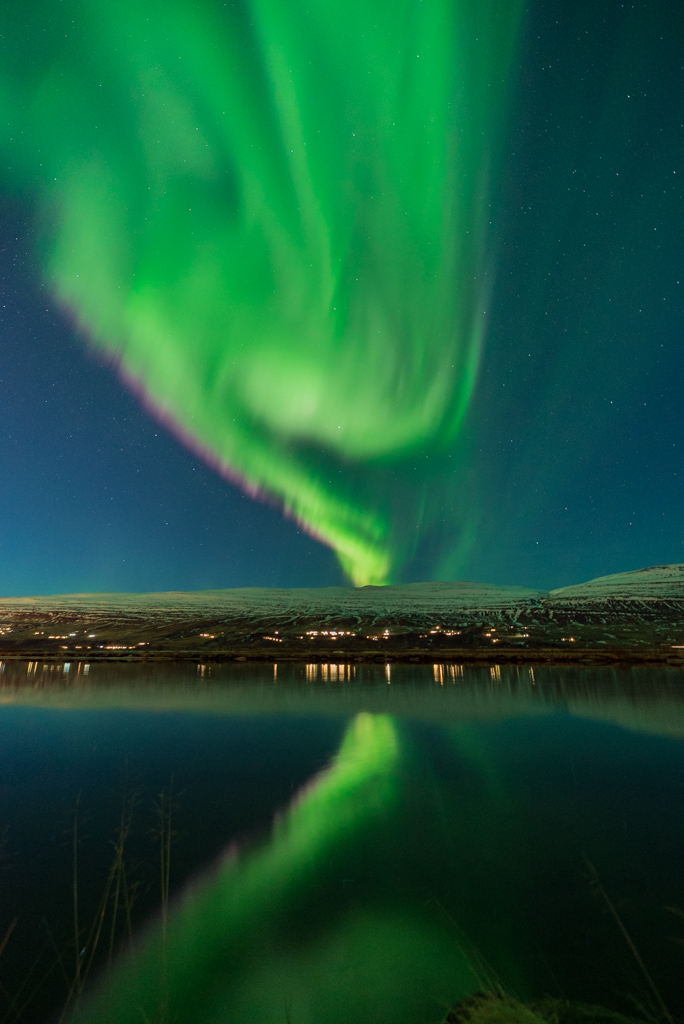
Northern Lights at Akureyri
What to Bring for a Northern Lights Adventure
To make your Aurora hunt comfortable and successful, here’s what you need:
Clothing Essentials
- Warm, wind- and waterproof layers
- Hat, gloves, and sturdy shoes
- Hand- and toe warmers
💡 Pro-Tip: Dress in layers and avoid cotton – wool is best.
Food & Drink Essentials
- Thermos with hot drinks (we like ginger tea or hot chocolate)
- Snacks (Liquorice is increasing the blood pressure and keeps you warm – that’s why it is so popular in Iceland
Equipment Essentials
- Headlamp (with red light option)
- Blanket or foldable chair
Photography Essentials
- Camera or phone with manual mode
- Tripod
- Spare batteries
With the right gear, you’ll be ready for an unforgettable night under Iceland’s Arctic sky!
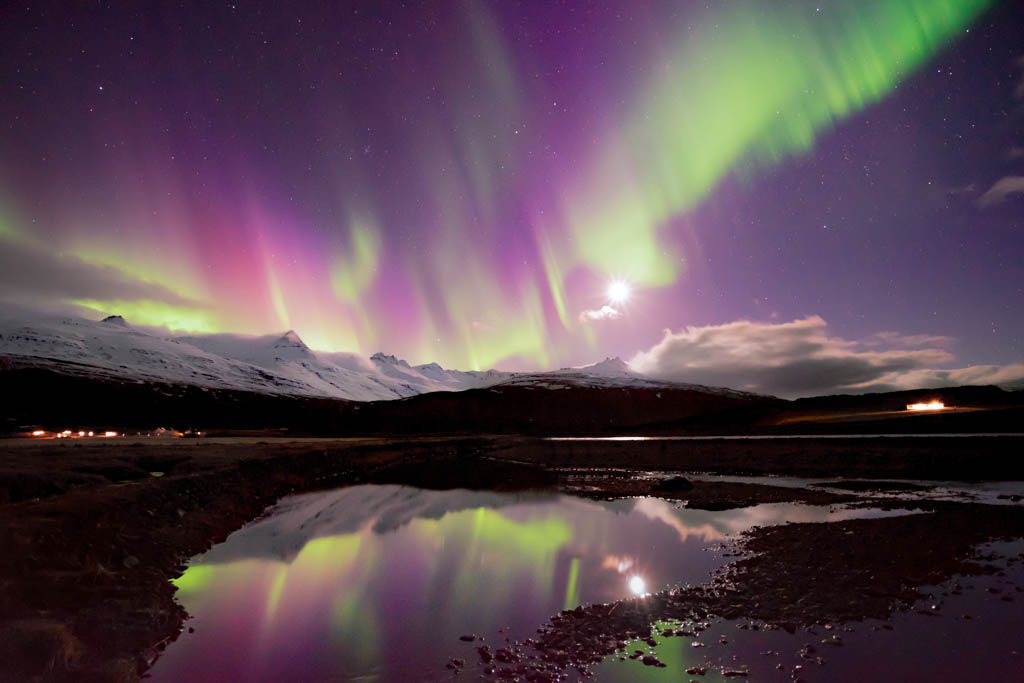
Lakes and ponds create beautiful reflections
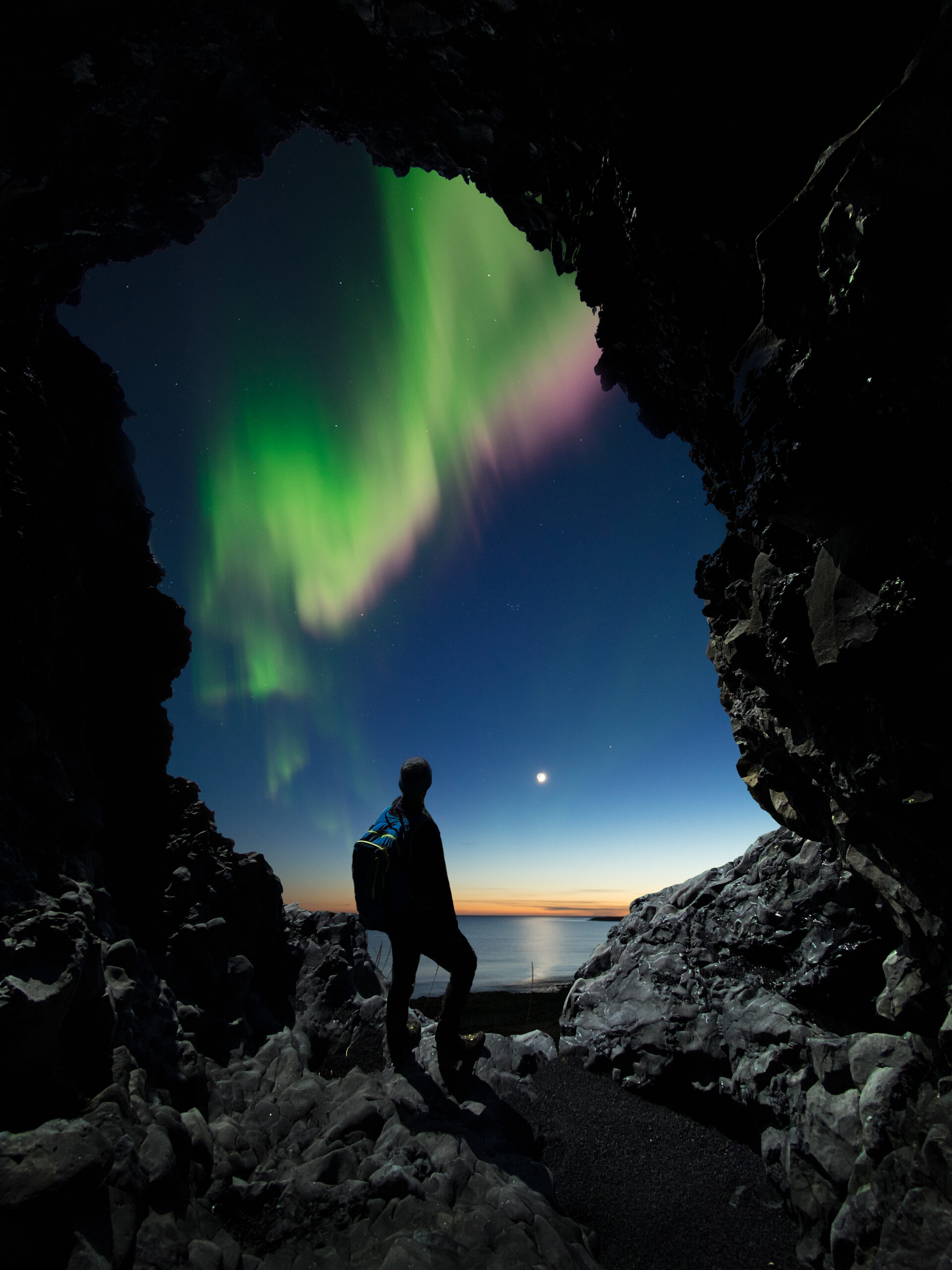
Northern Lights at Skógafoss
Hunting for the Northern Lights is always an adventure, and witnessing a display of this magical phenomenon will last in your memory for a lifetime.
Tell us about your experiences in the comments!
Join us on a guided Northern Lights Tour
FAQs About the Northern Lights
1. Can I see the Northern Lights in summer?
No, the midnight sun in summer makes the sky too bright for aurora visibility. Plan your trip for winter months.
2. What colors can I expect to see?
Green is the most common color, but under strong solar activity, you may see pink, red, and purple.
3. Are the Northern Lights guaranteed?
While auroras occur every night, visibility depends on weather and solar activity. Many tours offer a retry guarantee if you don’t see them.
External Resources
Enhance your aurora knowledge with these trusted resources:
-
NOAA Aurora Forecast – Real-time updates on geomagnetic activity.
-
Space.com Northern Lights Guide – Learn about the science behind the aurora borealis.
-
Visit Iceland Official Site – Plan your trip to Iceland with ease.
By following this guide, you’ll be well-prepared to experience one of nature’s most magical displays. Whether you’re planning your trip or already in Iceland, the aurora awaits!

